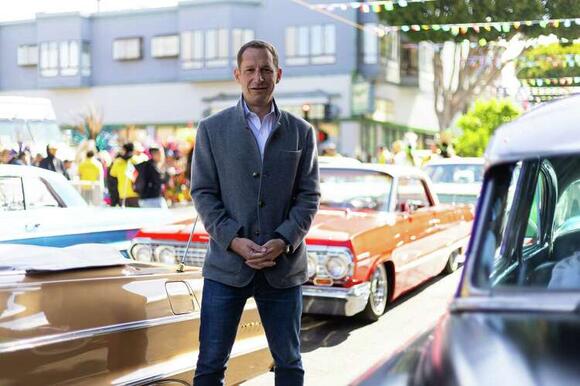San Francisco arts agencies to unite in historic realignment - NewsBreak

San Francisco’s three big arts agencies — Grants for the Arts, the San Francisco Arts Commission and the San Francisco Film Commission —will be under one roof starting in January.
As part of Mayor Daniel Lurie’s budget proposal, expected to be unveiled Friday, May 30, the three will operate side by side under a new super-agency with a newly created position leading the entire operation.
“Our arts community brings people from across the world to San Francisco — keeping them strong and vibrant is critical to our economic recovery,” Lurie said in a statement. “But our current structure simply isn’t doing enough to support them.” He shared hopes that the new structure would “ensure San Francisco’s arts and culture are set up to be resilient and drive our comeback.”

The next step is for the Board of Supervisors to revise Lurie’s proposal in June, with a finalized budget passed Aug. 1.
Kristen Jacobson, director of Grants for the Arts, announced the move in a letter to grantees on Thursday, May 29. She clarified to the Chronicle that the move isn’t about shrinking staff but “a desire to connect the dots more.” She did say, however, that the change would further Lurie’s goal of “making government smaller,” but that it was too early to elaborate on what that meant.

Jacobson added that current grants to the city’s museums and theater, dance, opera and music companies will not be affected.

Leaders of the SFAC, which supports individual artists, cultural equity initiatives and public art projects, and the film commission, which handles permits and incentives for filming in San Francisco, did not immediately respond to requests for comment.
The idea of uniting the agencies has been around for years. In 2022, Ralph Remington, director of cultural affairs at SFAC, told the Chronicle he brought it up when he was interviewing for his position.
But past conversations about combining the agencies have been complicated by law. The SFAC is part of the city charter dating back to 1932, with its leader reporting directly to the mayor-appointed arts commission members, while Proposition E, passed in 2018, solidified GFTA’s place in the City Administrator’s Office. Jacobson told the Chronicle that the new structure works around that hurdle by keeping GFTA’s budget in the City Administrator’s Office.

Artists and arts leaders have also historically been divided on the proposal. On the one hand, having a centralized agency could make logistical sense and, one day, streamline multiple burdensome grant applications. On the other hand, it could concentrate power in an arena — deciding which art to support — which particularly benefits from an array of perspectives.
Z Space Executive Director Shafer Mazow said while he wanted to be optimistic and believe in leaders’ good intentions, “we’ve seen too many pivots in GFTA in the past few years for me to feel confident that this latest plan can give the beleaguered SF arts community the support it needs,” he wrote via email.
The agency’s troubled leadership, under former director Vallie Brown, had already abruptly cut off many longtime grantees. Artists and producers worry particularly about the loss of general operating support, which has always been the revered purpose of GFTA. While many funders are keen to underwrite particular projects — a world-premiere play or opera, a new exhibit or initiative — it’s much harder for nonprofits to garner support for less glamorous but still essential budget items such as the electric bill or administrative salaries. GFTA helps fill that gap.

Jacobson said that while she could not predict the future, she vowed that under the super-agency, "I'll do everything I can within my power, and I know the whole GFTA team will as well, to advocate for how important and how critical and how precious general operating support is.”
She also pointed out that the new structure isn’t eliminating leadership perspectives.
“The thought process is having a side-by-side agency to hopefully keep strong voices at the head of the Film Commission, at the Head of GFTA, at the head of SFAC,” she explained.

Margaret Jenkins, of Margaret Jenkins Dance Company, was among those who in the past told the Chronicle that she worried about centralizing authority. But now she said she trusts Jacobson.
“As long as it doesn’t mean less money and a smaller pot that everyone will be fighting over, I think an ongoing conversation among these three organizations could yield more diverse funding in multiple arenas to a variety of artists,” she said Thursday.

The change comes at a volatile time in arts funding.
Earlier this month, the National Endowment for the Arts terminated a slew of grants to Bay Area arts organizations at the same time that President Donald Trump proposed eliminating the federal agency entirely. Weeks later, Governor Gavin Newsom proposed gutting the Performing Arts Equitable Payroll Fund that would have helped small arts organizations comply with state law requiring them to treat their workers as employees instead of independent contractors. The previous month, multiple city arts organizations were among those affected when the Human Rights Commission canceled $14 million in grant agreements through the Dream Keeper Initiative.
Correction: A previous version of this story misstated the reporting structure at the San Francisco Arts Commission. The director of cultural affairs reports to a 15-member commission, which is appointed by the mayor.









)